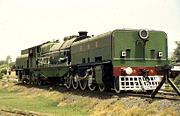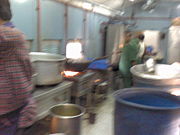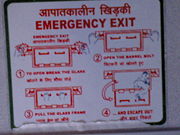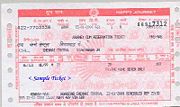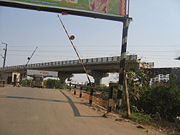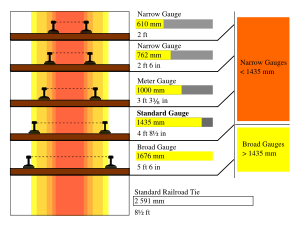Indian Railways
2008/9 Schools Wikipedia Selection. Related subjects: Railway transport
| भारतीय रेल, Indian Railways | |
|---|---|
 |
|
| Type | Departmental Undertaking of The Ministry of Railways, Government of India |
| Founded | April 16, 1853, nationalized in 1951 |
| Headquarters | New Delhi, India |
| Area served | India |
| Key people | Union Railway Minister: Laloo Prasad Yadav Minister of State for Railways (V): R. Velu Minister of State for Railways (R): Naranbhai J Rathwa Chairman, Railway Board: Kalyan C.Jena. |
| Industry | Railways and Locomotives |
| Products | Rail transport, Cargo Transport, Services |
| Revenue | ▲ INR Rs 13,334.72 Crores (~3.1 BUSD) |
| Employees | ~1,400,000 |
| Parent | Ministry of Railways (India) |
| Divisions | 16 Railway Zones (excluding Konkan Railway) |
| Website | www.indianrailways.gov.in |
Indian Railways (Hindi: भारतीय रेल Bhāratīya Rel), abbreviated as IR (भारे), is a Department of the Government of India, under the Ministry of Railways, and is tasked with operating the rail network in India. The Ministry is headed by a cabinet rank Railways Minister, while the Department is managed by the Railway Board. Indian Railways is not a private corporate body; however, of late IR has adopted a corporate management style.
Indian Railways has a total state monopoly on India's rail transport. It is one of the largest and busiest rail networks in the world, transporting seventeen million passengers and more than one million tonnes of freight daily. IR is the world's largest commercial or utility employer, with more than 1.6 million employees.
The railways traverse the length and breadth of the country; the routes cover a total length of 63,465 km (39,435 miles). As of 2005, IR owned a total of 222,379 wagons, 42,125 coaches and 7910 locomotives and ran a total of 14,444 trains daily, including about 8,702 passenger trains.
Railways were first introduced to India in 1853. By 1947, the year of India's independence, there were forty-two rail systems. In 1951 the systems were nationalized as one unit, becoming one of the largest networks in the world. Indian Railways operates both long distance and suburban rail systems.
History
A plan for a rail system in India was first put forward in 1832, but no further steps were taken for more than a decade. In 1844, the Governor-General of India Lord Hardinge allowed private entrepreneurs to set up a rail system in India. Two new railway companies were created and the East India Company was asked to assist them. Interest from investors in the UK led to the rapid creation of a rail system over the next few years. The first train in India became operational on 22 December 1851, and was used for the hauling of construction material in Roorkee. A year and a half later, on 16 April 1853, the first passenger train service was inaugurated between Bori Bunder, Bombay and Thane. Covering a distance of 34 km (21 miles), it was hauled by three locomotives, Sahib, Sindh and Sultan. This was the formal birth of railways in India.
The British government encouraged new railway companies backed by private investors under a scheme that would guarantee an annual return of five percent during the initial years of operation. Once established, the company would be transferred to the government, with the original company retaining operational control. By 1875, about £95 million were invested by British companies in Indian guaranteed railways. The route mileage of this network was about 14,500 km (9,000 miles) by 1880, mostly radiating inward from the three major port cities of Bombay (Mumbai), Madras (Chennai) and Calcutta ( Kolkata). By 1895, India had started building its own locomotives, and in 1896 sent engineers and locomotives to help build the Uganda Railway.
Soon various independent kingdoms built their own rail systems and the network spread to the regions that became the modern-day states of Assam, Rajasthan and Andhra Pradesh. A Railway Board was constituted in 1901, but decision-making power was retained by the Viceroy, Lord Curzon. The Railway Board operated under aegis of the Department of Commerce and Industry and had three members: a government railway official serving as chairman, a railway manager from England and an agent of one of the company railways. For the first time in its history, the Railways began to make a tidy profit. In 1907, almost all the rail companies were taken over by the government.
The following year, the first electric locomotive appeared. With the arrival of the First World War, the railways were used to meet the needs of the British outside India. By the end of the First World War, the railways had suffered immensely and were in a poor state. The government took over the management of the Railways and removed the link between the financing of the Railways and other governmental revenues in 1920, a practice that continues to date with a separate railway budget.
The Second World War severely crippled the railways as rolling stock was diverted to the Middle East, and the railway workshops were converted into munitions workshops. At the time of independence in 1947, about 40 per cent of the railways then went to the newly independent republic of Pakistan. A total of forty-two separate railway systems, including thirty-two lines owned by the former Indian princely states, were amalgamated as a single unit which was christened as the Indian Railways.
The existing rail networks were abandoned in favour of zones in 1951 and a total of six zones came into being in 1952. As the economy of India improved, almost all railway production units were indigenised. By 1985, steam locomotives were phased out in favour of diesel and electric locomotives. The entire railway reservation system was streamlined with computerisation in 1995.
Indian Railways is one of the largest employers in the world. Very few corporate entities, public or private, have a larger workforce.
Railway zones
For administrative purposes, Indian Railways is divided into seventeen zones.
| Sl. No | Name | Abbr. | Date Established | Headquarters | Divisions |
|---|---|---|---|---|---|
| 1. | Northern Railway | NR | April 14, 1952 | Delhi | Delhi, Ambala, Firozpur, Lucknow, Moradabad |
| 2. | North Eastern Railway | NER | 1952 | Gorakhpur | Izzatnagar, Lucknow, Varanasi |
| 3. | Northeast Frontier Railway | NFR | 1958 | Guwahati | Alipurduar, Katihar, Lumding, Rangia, Tinsukia |
| 4. | Eastern Railway | ER | April, 1952 | Kolkata | Howrah, Sealdah, Asansol, Malda |
| 5. | South Eastern Railway | SER | 1955 | Kolkata | Adra, Chakradharpur, Kharagpur, Ranchi |
| 6. | South Central Railway | SCR | October 2, 1966 | Secunderabad | Secunderabad, Hyderabad, Guntakal, Guntur, Nanded, Vijayawada |
| 7. | Southern Railway | SR | April 14, 1951 | Chennai | Chennai, Madurai, Palghat, Tiruchchirapalli, Trivandrum, Salem ( Coimbatore) |
| 8. | Central Railway | CR | November 5, 1951 | Mumbai | Mumbai, Bhusawal, Pune, Solapur, Nagpur |
| 9. | Western Railway | WR | November 5, 1951 | Mumbai | Mumbai Central, Baroda, Ratlam, Ahmedabad, Rajkot, Bhavnagar |
| 10. | South Western Railway | SWR | April 1, 2003 | Hubli | Hubli, Bangalore, Mysore |
| 11. | North Western Railway | NWR | October 1, 2002 | Jaipur | Jaipur, Ajmer, Bikaner, Jodhpur |
| 12. | West Central Railway | WCR | April 1, 2003 | Jabalpur | Jabalpur, Bhopal, Kota |
| 13. | North Central Railway | NCR | April 1, 2003 | Allahabad | Allahabad, Agra, Jhansi |
| 14. | South East Central Railway | SECR | April 1, 2003 | Bilaspur, CG | Bilaspur, Raipur, Nagpur |
| 15. | East Coast Railway | ECoR | April 1, 2003 | Bhubaneswar | Khurda Road, Sambalpur, Visakhapatnam |
| 16. | East Central Railway | ECR | October 1, 2002 | Hajipur | Danapur, Dhanbad, Mughalsarai, Samastipur, Sonpur |
| 17. | Konkan Railway† | KR | January 26, 1998 | Navi Mumbai | None |
†Konkan Railway (KR) is constituted as a separately incorporated railway, with its headquarters at Belapur CBD (Navi Mumbai). It comes under the control of the Railway Ministry and the Railway Board.
The Calcutta Metro is owned and operated by Indian Railways, but is not a part of any of the zones. It is administratively considered to have the status of a zonal railway. Each zonal railway is made up of a certain number of divisions, each having a divisional headquarters. There are a total of sixty-seven divisions.
Passenger services
Indian Railways operates 8,702 passenger trains and transports 17 million daily across twenty-eight states and three union territories (Delhi, Puducherry (formerly Pondicherry) and Chandigarh). Sikkim, Arunachal Pradesh and Meghalaya are the only states not connected.
The passenger division is the most preferred form of long distance transport in most of the country.
A standard passenger train consists of eighteen coaches, but some popular trains can have up to 24 coaches. Coaches are designed to accommodate anywhere from 18 to 72 passengers, but may actually accommodate many more during the holiday seasons and on busy routes. Most regular trains have coaches connected through vestibules. However, "unreserved coaches" are not vestibule-connected with the rest of the train.
Production Services
The Indian Railways manufactures a lot of its rolling stock and heavy engineering components. This is largely due to historical reasons. As with most developing economies, the main reason is import substitution of expensive technology related products. This was relevant when the general state of the national engineering industry was immature.
Production Units, the manufacturing plants of the Indian Railways, are managed directly by the ministry. The General Managers of the PUs report to the Railway Board. The Production Units are:
- Chittaranjan Locomotive Works, Chittaranjan
- Diesel Locomotive Works, Varanasi
- Diesel-Loco Modernisation Works, Patiala
- Integral Coach Factory, Chennai
- Rail Coach Factory, Kapurthala
- Rail Wheel Factory, Bangalore
Other independent units of Indian Railways are:
- Central Organization For Railway Electrification, Allahabad
- Central Organization For Modernization of Workshops, New Delhi
Important maintenance workshops on IR are:
- Southern Railway Workshop, Ponmalai (Golden Rock), Tiruchirapalli
- Rail Spring Karkhana, Gwalior
Bharat Earth Movers Limited, Bangalore (BEML) is not organisationally related to the Indian Railways however it manufactures coaches for both the Indian Railways and the New Delhi Metro system.
Suburban rail
Many cities have their own dedicated suburban networks to cater to commuters. Currently, suburban networks operate in Mumbai (Bombay), Chennai (Madras), Kolkata (Calcutta), Delhi, Hyderabad and Pune. Hyderabad, and Pune do not have dedicated suburban tracks but share the tracks with long distance trains. New Delhi, Kolkata, and Chennai have their own metro networks, namely the New Delhi Metro, the Kolkata Metro,and the Chennai MRTS- Mass Rapid Transport System, with dedicated tracks mostly laid on a flyover as in other local EMU suburban service in Mumbai and Kolkata.
Suburban trains that handle commuter traffic are mostly electric multiple units. They usually have nine coaches or sometimes twelve to handle rush hour traffic (Hyderabad MMTS; abbreviation for Multi Modal Transport System has mostly six coach train with a single nine coach one). One unit of an EMU train consists of one power car and two general coaches. Thus a nine coach EMU is made up of three units having one power car at each end and one at the middle. The rakes in Mumbai run on direct current, while those elsewhere use alternating current. A standard coach is designed to accommodate 96 seated passengers, but the actual number of passengers can easily double or triple with standees during rush hour. The Kolkata metro has the administrative status of a zonal railway, though it does not come under the seventeen railway zones.
The Suburban trains in Mumbai handle more rush than any other suburban network in the world. The network has three lines viz, western, central and harbour. The Central Line starts from Chhatrapati Shivaji Terminus (CST) (Formerly Victoria Terminus or VT) and runs for more than 100 km till Kasara. The Western Line starting from Churchgate runs again for more than 100 km till Dahanu Road. It is thus the longest suburban rail system in the world. Also, it is busiest suburban network in the world, in the sense that it carries more than 6 million passengers each day.
Freight
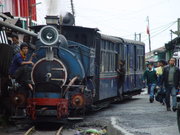
Indian Railway carries a huge variety of goods ranging from mineral ores, fertilizers and petrochemicals, agricultural produce, iron & steel, multimodal traffic and others. Ports and major urban areas have their own dedicated freight lines and yards. Many important freight stops have dedicated platforms and independent lines.
Indian Railways makes 70% of its revenues and most of its profits from the freight sector, and uses these profits to cross-subsidise the loss-making passenger sector. However, competition from trucks which offer cheaper rates has seen a decrease in freight traffic in recent years. Since the 1990s, Indian Railways has switched from small consignments to larger container movement which has helped speed up its operations. Most of its freight earnings come from such rakes carrying bulk goods such as coal, cement, food grains and iron ore.
Indian Railways also transports vehicles over long distances. Trucks that carry goods to a particular location are hauled back by trains saving the trucking company on unnecessary fuel expenses. Refrigerated vans are also available in many areas. The "Green Van" is a special type used to transport fresh food and vegetables. Recently Indian Railways introduced the special 'Container Rajdhani' or CONRAJ, for high priority freight. The highest speed notched up for a freight train is 100 km/h (62 mph) for a 4,700 metric tonne load.
Recent changes have sought to boost the earnings from freight. A privatization scheme was introduced recently to improve the performance of freight trains. Companies are being allowed to run their own container trains. The first length of an 11,000-kilometre (6,800 mi) freight corridor linking India's biggest cities has recently been approved. The railways has increased load limits for the system's 220,000 freight wagons by 11%, legalizing something that was already happening. Due to increase in manufacturing transport in India that was augmented by the increase in fuel cost, transportation by rail became advantageous financially. New measures such as speeding up the turnaround times have added some 24% to freight revenues.
Freight charges
This is a chart of average rail freight charges in 2007 with figures in United States Dollars. See also
| Item | Freight per tonne |
|---|---|
| Cement | $12.96 |
| Coal | $13.71 |
| Iron ore | $15.19 |
| Fertiliser | $16.53 |
| Raw materials for steel plants | $17.45 |
| Container service | $18.58 |
| Petroleum oil & lubricant | $20.82 |
| Food grains | $23.65 |
| Iron & finished steel | $26.08 |
| Other goods | $15.79 |
Notable trains and achievements
The Darjeeling Himalayan Railway, a narrow gauge railway that still regularly uses steam as well as diesel locomotives is classified as a World Heritage Site by UNESCO. The route started earlier at Siliguri and now at New Jalpaiguri in the plains in West Bengal and traverses tea gardens en route to Darjeeling, a hill station at an elevation of 2,134 metres (7,000 ft). The highest station in this route is Ghum. The Nilgiri Mountain Railway, in the Nilgiri Hills in southern India, is also classified as a World Heritage Site by UNESCO. It is also the only rack railway in India. The Chatrapati Shivaji Terminus (formerly Victoria Terminus) railway station in Mumbai is another World Heritage Site operated by Indian Railways.
The Palace on Wheels is a specially designed train, frequently hauled by a steam locomotive, for promoting tourism in Rajasthan. The Maharashtra government did try to introduce the Deccan Odyssey along the Konkan route, but it did not enjoy the same success as the Palace on Wheels. The Karnataka government has recently introduced The Golden Chariot train which connects popular tourist destinations in Karnataka and Goa. The Samjhauta Express is a train that runs between India and Pakistan. However, hostilities between the two nations in 2001 saw the line being closed. It was reopened when the hostilities subsided in 2004. Another train connecting Khokhrapar (Pakistan) and Munabao (India) is the Thar Express that restarted operations on February 18, 2006; it was closed down after the 1965 Indo-Pak war. The Kalka Shimla Railway till recently featured in the Guinness Book of World Records for offering the steepest rise in altitude in the space of 96 kilometres.
The Lifeline Express is a special train popularly known as the "Hospital-on-Wheels" which provides healthcare to the rural areas. This train has a carriage that serves as an operating room, a second one which serves as a storeroom and an additional two that serve as a patient ward. The train travels around the country, staying at a location for about two months before moving elsewhere.
Among the famous locomotives, the Fairy Queen is the oldest running locomotive on the mainline (though only for specials) in the world today, though the distinction of the oldest surviving locomotive that has recently seen service belongs to John Bull. Kharagpur railway station also has the distinction of being the world's longest railway platform at 1072 m (3,517 ft). The Ghum station along the Darjeeling Toy Train route is the second highest railway station in the world to be reached by a steam locomotive. Indian Railways operates 7,910 locomotives; 42,125 Coaching vehicles and 222,379 freight wagons. There are a total of 6,853 stations; 300 yards; 2,300 goods-sheds; 700 repair shops and a total workforce of 1.54 million.
The shortest named station is Ib and the longest is Sri Venkatanarasimharajuvaripeta. The Himsagar Express, between Kanyakumari and Jammu Tawi, has the longest run in terms of distance and time on Indian Railways network. It covers 3,745 km (2,327 miles) in about 74 hours and 55 minutes. The Bhopal Shatabdi Express is the fastest train in India today having a maximum speed of 150 km/h (93.7 mph) on the Faridabad-Agra section. The fastest speed attained by any train is 184 km/h (114 mph) in 2000 during test runs. This speed is much lower than fast trains in other parts of the world. The difference in these speeds could be in part attributed to the fact that the trains run on existing tracks, which were not designed for such high speeds.
Organisational structure
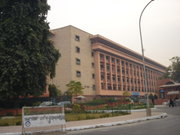
Indian Railways is a department of the Government, being owned and controlled by the Government of India, via the Ministry of Railways rather than a private company. As of 2008, the Railway Ministry is headed by Laloo Prasad Yadav, the Union Minister for Railways and assisted by two junior Ministers of State for Railways, R. Velu and Naranbhai J. Rathwa. Indian Railways is administered by the Railway Board, which has six members and a chairman.
Each of the sixteen zones is headed by a General Manager (GM) who reports directly to the Railway Board. The zones are further divided into divisions under the control of Divisional Railway Managers (DRM). The divisional officers of engineering, mechanical, electrical, signal & telecommunication, accounts, personnel, operating, commercial and safety branches report to the respective Divisional Manager and are in charge of operation and maintenance of assets. Further down the hierarchy tree are the Station Masters who control individual stations and the train movement through the track territory under their stations' administration. In addition to the zones, the six production units (PUs) are each headed by a General Manager (GM), who also reports directly to the Railway Board.
In addition to this the Central Organisation for Railway Electrification (CORE), Metro Railway, Calcutta and construction organisation of N F Railway are also headed by a General Manager. CORE is located at Allahabad. This organisation undertakes electrification projects of Indian Railway and monitors the progress of various electrification projects all over the country.
Apart from these zones and production units, a number of Public Sector Undertakings (PSU) are under the administrative control of the ministry of railways. These PSU units are:
- Dedicated Freight Corridor Corporation of India
- Indian Railways Catering and Tourism Corporation
- Konkan Railway Corporation
- Indian Railway Finance Corporation
- Mumbai Rail Vikas Corporation
- Railtel Corporation of India – Telecommunication Networks
- RITES Ltd. – Consulting Division of Indian Railways
- IRCON International Ltd. – Construction Division
- Rail Vikas Nigam Limited
- Container Corporation of India Limited
- Rail Land Development Authority –for commercial development of vacant railway land, is a statutory authority formed through an amendment of the Railways' Act, 1989
- Centre for Railway Information Systems is an autonomous society under Railway Board, which is responsible for developing the major software required by Indian Railways for its operations.
Rail budget and finances
The Railway Budget deals with the induction and improvement of existing trains and routes, the modernisation and most importantly the tariff for freight and passenger travel. The Parliament discusses the policies and allocations proposed in the budget. The budget needs to be passed by a simple majority in the Lok Sabha (India's Lower House). The comments of the Rajya Sabha (Upper House) are non binding. Indian Railways are subject to the same audit control as other government revenue and expenditures. Based on the anticipated traffic and the projected tariff, the level of resources required for railway's capital and revenue expenditure is worked out. While the revenue expenditure is met entirely by railways itself, the shortfall in the capital (plan) expenditure is met partly from borrowings (raised by Indian Railway Finance Corporation) and the rest from Budgetory support from the Central Government. Indian Railways pays dividend to the Central Government for the capital invested by the Central Government.
As per the Separation Convention (on the recommendations of the Acworth Committee), 1924, the Railway Budget is presented to the Parliament by the Union Railway Minister, two days prior to the General Budget, usually around 26 February. Though the Railway Budget is separately presented to the Parliament, the figures relating to the receipt and expenditure of the Railways are also shown in the General Budget, since they are a part and parcel of the total receipts and expenditure of the Government of India. This document serves as a balance sheet of operations of the Railways during the previous year and lists out plans for expansion for the current year.
The formation of policy and overall control of the railways is vested in Railway Board comprising the Chairman, Financial Commissioner and other functional Members for Traffic, Engineering, Mechanical, Electrical and Staff matters.
Under Lalloo Prasad Yadav, the previously loss making Indian railways which was under the verge of bankruptcy, made a remarkable turnaround by reporting a cash surplus of Rs 9000 cr in 2005, which jumped to Rs 14000 cr in 2006 then again rose to Rs 20,000 cr in 2007. In 2007-08, a cash surplus before Dividend of Rs.25,000 cr was reported. .
The operating ratio has also improved to 76% (stated in 2008 budget), which is the best in the world( second placed Canada has 78.7%).In the last four years under his tenure as railway minister till 2008, the plan size of the Railways has increased from Rs. 13000 cr to Rs. 30000 cr.Annual Plan of 2008-09 is the highest ever annual plan of the railways. It is proposed to invest Rs. 37,500 cr, which is 21 percent more than the previous year.
Budget Estimates-2008 for Freight, Passenger, Sundry other Earnings and other Coaching Earnings have been kept at Rs. 52,700 cr, Rs 21,681 cr, Rs. 5,000 cr and Rs 2,420 cr respectively. Maintaining an overall double digit growth, Gross Traffic Earnings have been projected as Rs 81,801 cr Around 20% of the passenger revenue is earned from the upper class segments of the passenger segment (the air-conditioned classes).
A new challenge faced by Indian Railways is competition from low cost airlines that has recently made its début in India. In a cost cutting move, the Railways plan to minimise unwanted cessations, and scrap unpopular routes.
Current issues and upgrades
Although accidents such as derailment and collisions are less common in recent times, many are run over by trains, especially in crowded areas. Indian Railways have accepted the fact that given the size of operations, eliminating accidents is an unrealistic goal, and at best they can only minimize the accident rate. Human error is the primary cause (83%) of mishaps. In the past, Konkan Railway route has suffered from landslides in the monsoon season, causing fatal accidents.
Outdated communication, safety and signaling equipment, which used to contribute to failures in the system, is being updated with the latest technology. A number of train accidents happened on account of a system of manual signals between stations, so automated signaling is getting a boost. However, the changeover to a new system would require a substantial investment. It is felt that this would be required given the gradual increase in train speeds and lengths, that would tend to make accidents more dangerous. In the latest instances of signaling control by means of interlinked stations (e.g., Chennai - Washermanpet), failure-detection circuits are provided for each track circuit and signal circuit with notification to the signal control centres in case of problems. This is currently available in a small subset of the overall IR system, although anti-collision devices are to be extended to the entire system. Aging colonial-era bridges and century-old tracks also require regular maintenance and upgrading.
In recent years Indian Railways has laid claim to a financial turnaround, with (unaudited) operating profits going up substantially. Credit for this achievement has been claimed by current Indian Railway Minister, Mr Lalu Prasad Yadav, who asserts that he made significant improvements in operating efficiency of goods traffic after he took over as Railway Minister in May 2004.
The Sixth Pay Commission has been constituted in India to review the pay structure of Government employees, and its recommendations are expected by the end of 2008. Based on its recommendations, the salaries of all Railways officers and staff are expected to be revised with retrospective effect (w.e.f. January 1, 2006). If previous Pay Commissions are taken as an indicator, this revision could be 50%, thus having an impact on present and future Railway budgets.
The Rajdhani Express and Shatabadi Express are the fastest and most luxurious trains of Indian Railways, though they face competition from new low-cost airlines as the trains travel only at 130-140 km/hr (c.f. Fastest trains in India). At least five corridors are under consideration for the introduction of high speed bullet trains to India with expert assistance from France. It is estimated that to modernise Indian Rail and bring it up to international standards, over US$200 billion in investments would be required.
These are refreshing times for IR as it becomes more user-friendly. Expansive and expensive plans are underway to upgrade stations, coaches, tracks, services, safety, and security. Initially, various upgrade and overhaul work will be performed at more than fifty stations, some of it by private contract. All meter gauge lines in the country will be converted to broad gauge (see Project Unigauge). New stainless steel LHB design coaches, manufactured in India, are due to be introduced on all Rajdhani, Shatabdi, mail and express trains by 2011. These coaches will enhance the safety and riding comfort of passengers besides having more carrying capacity, and in time will replace thousands of old model coaches throughout Indian Railways. More durable and conforming polyurethane paint is now being used to enhance the quality of rakes and significantly reduce the cost of repainting. Improved ventilation and illumination are part of the new scheme of things too, says Rail Bhawan (HQ in New Delhi). New manufacturing units will be set up to produce state-of-the-art locomotives and coaches.
As a start, the Delhi station is being upgraded with four new stations being built to ease the congestion. Railway authorities have invited private companies to modernise the Delhi station in partnership with the public sector. British firm Terry Farrell and Partners has been hired by the railway ministry to re-design the station. The renovation of Delhi station marks the start of government efforts to upgrade both the nation's railway stations and its routes. The plan is to separate arrivals and departures areas on different levels. Tracks will be widened, enabling a switch to faster and bigger trains that can speed up the passenger flow. On a system-wide level, new track is being laid, tunnels blasted out of mountains, bridges and brand new stations being built, in remote parts of the country such as the northeastern states and Kashmir. German, Chinese, and other foreign railway expertise is being pressed into service in IR's makeover story, but by the same token Indian Railways lends a helping hand to other countries' national railways.
Sanitation in trains and stations throughout the system is getting more attention with the introduction of eco-friendly, discharge-free green toilets developed by IIT Kanpur. This costly makeover is expected to take three years. Fire detection systems will be installed on trains in a phased manner, and new rodent-control and cleanliness procedures are also working their way into the many zones of IR. Central Railway's 'Operation Saturday' is gradually making progress, station by station, in the cleanup of its Mumbai division.
Base kitchens and food services across the system are also slated for a makeover, while rail ticket booking through ATMs on select trains and through cell(ular) phone SMS is being put in place. Channel music, TV screens showing the latest films, and optional menus from five-star hotels are being introduced on the Rajdhani and Shatabdi Express. The National Institute of Design (NID) was roped in to spice up the upholstery and coach interiors of the two high-end trains to give them a corporate designer look. There is now competitive bidding to lease advertising space on railway buildings, stations and some trains. Significantly, several IT initiatives are being phased in to better handle ticketing, freight, rolling stock (wagons), terminals, and rail traffic, including the use of Global Positioning System (GPS) for train tracking in real time. Senior managers who now undergo advanced training overseas will soon be able to attend the new International Railway Strategic Management Institute (IRSMI) being set up in New Delhi.
In summation, IR is changing compellingly for the better, and contributing to the economic vitality of a sub-continent that is evolving at a phenomenal rate, and of which it is an integral part.
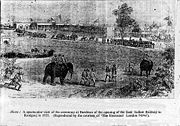
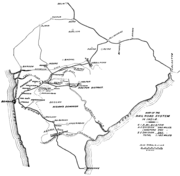
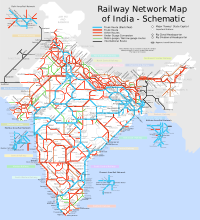
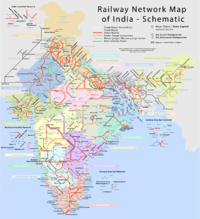
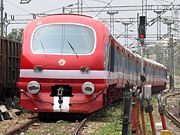
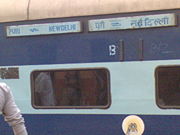
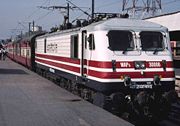
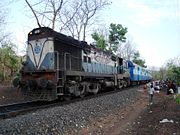
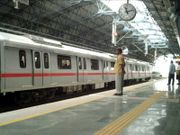
![Mumbai's suburban (local) [2] trains handle 3 million people daily](../../images/345/34555.jpg)

